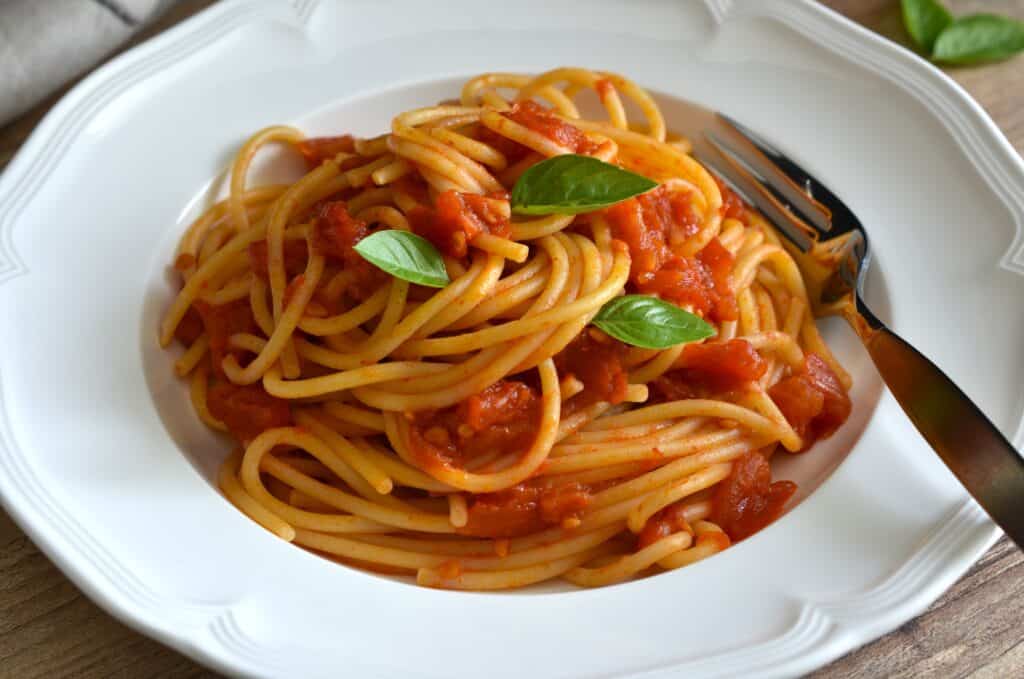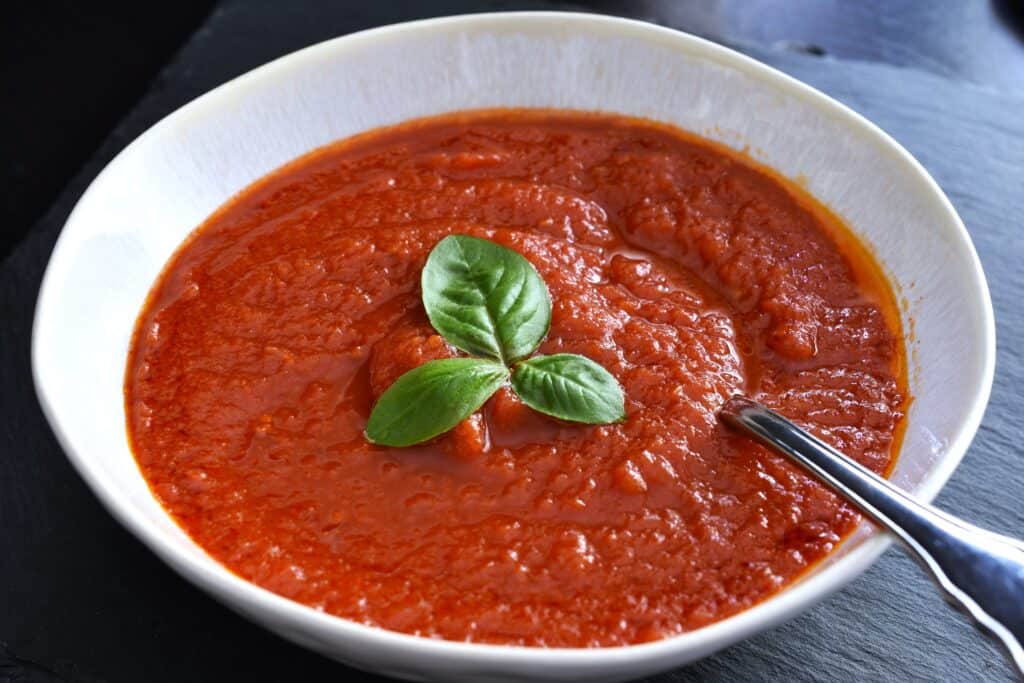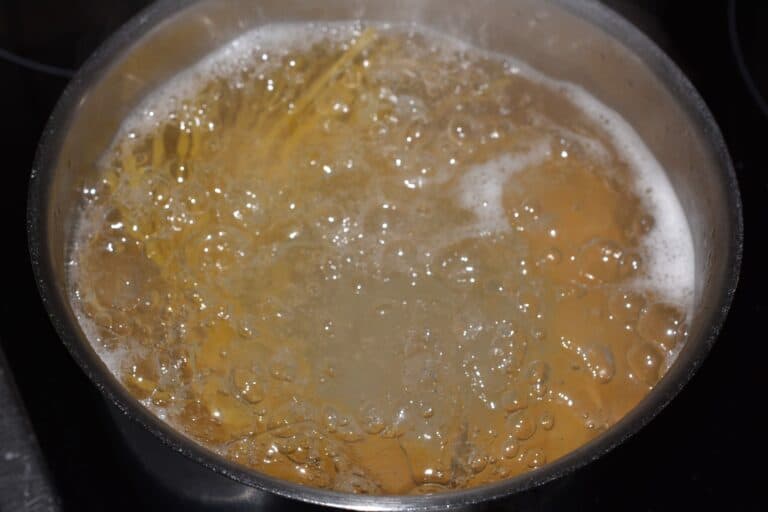What are the secrets to perfect Italian spaghetti with fresh tomato sauce? Fresh, high-quality ingredients and a little know-how! Learn how to elevate this simple dish from good to buonissimo with all the tips and tricks to make it authentically Italian.
Homemade spaghetti sauce with fresh tomatoes is one of the highlights of late summer. A true icon of Italy’s pasta culture, spaghetti with tomato sauce is one of the simplest yet most popular dishes ever created. Like pizza, its popularity has spread far beyond Italy, captivating taste buds around the world long before the internet made sharing recipes so easy.
Spaghetti al sugo di pomodoro fresco has been a staple of Italian tradition for centuries; it’s a dish that brings people together and a reminder of the simple pleasures in life. “Mette tutti d’accordo“, they say in Italian, meaning it’s something everyone will agree on and happily eat.

Authentic Italian spaghetti sauce with fresh summer tomatoes
Ripe tomatoes, extra virgin olive oil and a pinch of sea salt are all you need to recreate this Italian classic that’s absolutely bursting with summer flavours. You can make this dish as simple or as festive as you like – it’s perfect for a quick weeknight dinner yet equally suitable for a festive gathering with friends.
Pasta with fresh tomato sauce is an economical, easy meal that you can have on the table in 30 minutes. Most Italians would serve it as a first course, followed by vegetables and some kind of protein, making it a nutritionally complete meal. Spaghetti with summer tomato sauce is the one dish I never get tired of, no matter how many times I eat it. It’s also my lifesaver when there are no vegan options on the menu. Any Italian restaurant will whip you up a plate of pasta with tomato sauce if you ask them.
Now, let’s dive into the kitchen and bring a feast of flavours to your table from the heart of the Italian countryside!

How to make perfect spaghetti with fresh tomato sauce
Ingredients
You’ll find the exact quantities of each ingredient in the recipe card at the bottom of this page.
Spaghetti
Use Italian spaghetti – the best you can find. My favourite is Rummo spaghetti grossi no. 5, but there are many other excellent manufacturers out there, like Garofolo, La Molisana, De Cecco and Voiello. Barilla and Buitoni are also good and probably more readily available outside Italy.
Spaghetti thickness is indicated by a number, often preceded by the # sign. I advise against using very thin spaghetti, such as spaghettini (#3), because it’s almost impossible to get it on the plates and in front of your guests before it overcooks. Standard-sized spaghetti (#5) is ideal for fresh tomato sauce. Most non-Italians (and some Italians) find spaghettoni (usually marked #7 or higher) too thick for their liking. Ultimately, the choice is a matter of personal preference. Bear in mind that the numbers and thicknesses can vary depending on the brand. Rummo spaghettoni grossi is labelled number 220, which seems to defy any logical numbering system.
For a healthier option, you could choose wholemeal spaghetti. Wholemeal pasta has a higher fibre content and more nutrients. It retains more vitamins (like B vitamins) and minerals (such as magnesium and iron) than white pasta, as it is made from whole grains. Wholemeal pasta has a lower glycemic index, which means a slower rise in blood sugar levels compared to white pasta, which is beneficial for sustained energy.
Fresh tomatoes
Look for ripe, fresh tomatoes for this recipe. While you can use tinned tomatoes or passata instead, they can never truly replicate the vibrant flavours of fresh tomatoes.
Which tomatoes are best for fresh tomato spaghetti sauce?
Different types of tomatoes yield different flavoured sauces. My personal favourites, San Marzano, are considered the gold standard in Italy for making tomato sauce. You can use the tomatoes you like best for this recipe – the most important thing is that they are ripe and flavourful. To help you decide, Let’s take a look at some tomato types and their pros and cons for making fresh tomato sauce.
Italian plum tomatoes – San Marzano and Roma
Italian plum tomatoes are top of the list for being the most suitable. San Marzano and Roma are both varieties of plum tomato and among the most common types used for canning (and for making fresh tomato sauce). Both contain very little juice, which makes it easy to reduce the sauce without overcooking it. They also have few seeds, which means you won’t need to strain the sauce to eliminate them. Less seeds and juice translates to more pulp in the sauce, which is exactly what we’re looking for. So, which is better San Marzano or Roma?
San Marzano tomatoes are renowned for their rich, sweet flavour and low acidity, which makes them perfect for creating a balanced and flavourful sauce. Compared to the Roma tomato, San Marzano tomatoes are longer and more slender with a slightly irregular shape. The flesh is thicker with fewer seeds, and the taste is stronger, sweeter, and less acidic. Roma tomatoes are shorter and plumper, resembling large eggs. They are more acidic in flavour, cheaper, and easier to source. San Marzano are the crème de la crème – Roma tomatoes are a good second best.
Beef tomatoes
Beefsteak tomatoes are generally large, round, and slightly flattened, with a ribbed appearance. They are juicy with a high flesh-to-seed ratio and a mild, sweet flavour. They are more suitable for slicing for use in sandwiches, burgers, and salads than for making sauce.
Oxheart tomatoes are named for their unique heart-like shape. They are typically smaller than beefsteak tomatoes but still large compared to most other varieties. They tend to have a dense, meaty texture, similar to beefsteak tomatoes, but are less watery and have fewer seeds. Oxheart tomatoes are known for their rich, sweet flavor, making them perfect for Italian speciality salads, like Caprese, but they can also be used for sauces. They will take longer to reduce to a sauce consistency, therefore increasing the risk of overcooking them and losing that fresh tomato flavour.
Cherry and grape tomatoes
Cherry tomatoes and grape tomatoes are another viable option. Depending on the variety, cherry tomatoes can be sweet or tart. They have a brighter, more vibrant flavour and are often available year-round. Among the disadvantages are lots of seeds and juice, and they are very fiddly to skin.
Vine-ripened and globe tomatoes
Vine-ripened and globe tomatoes can be suitable for making fresh tomato sauce. They are widely available all year round, affordable, and usually have a good balance of sweetness and acidity. When fully ripe, they can make a flavourful sauce. On the negative side, they have a higher water content than some other tomatoes, which can result in a thinner sauce unless you cook it longer to reduce the liquid. Their flavour can also be bland, especially if they are out of season or not perfectly ripe.
Heirloom tomatoes
Heirloom tomatoes can work well for making fresh tomato sauce. They offer a rich, complex flavor profile with a natural sweetness and depth that can enhance your sauce. Their meaty texture and lower water content helps create a thicker, more flavourful sauce. They come in a variety of colours and flavours, which may or may not look good in a sauce. Heirlooms are sometimes prohibitively expensive and less consistently available than other types of tomatoes. They are really only suitable for making small amounts of sauce.
I grow tomatoes in my garden, and I make my fresh tomato sauces primarily with San Marzano tomatoes, with the odd cherry or Roma thrown in if they are too ripe for salad, etc. A mix of tomato varieties is a good solution, especially if you grow your own.
Olive oil
Don’t compromise on the quality of the olive oil in this recipe. Organic, cold-pressed extra virgin olive oil will significantly enhance the flavour of this dish.
garlic (optional)
The garlic delicately infuses the oil with flavour and is removed at the end. If you’re not a fan of garlic, feel free to leave it out.
Salt
Unrefined sea salt is a healthier alternative to common table salt. I use Guérande natural grey sea salt, which is hand-harvested in France.
Fresh basil (optional)
Fresh basil adds a burst of summer flavour. Use it raw for a bright, pungent kick or add it to the sauce 10 minutes before serving for a more subtle, nuanced flavour. If you opt to use basil, you might want to consider leaving out the garlic.

Method – How to make authentic Italian spaghetti with fresh tomato sauce
You’ll find step-by-step instructions with photos in the recipe card at the bottom of this page.
Make the fresh tomato sauce
Make the sauce before you start cooking the pasta!
- Wash the tomatoes, remove the core and make a long slit in each one using a sharp knife. Plunge them into boiling water and leave them submerged for a minute. Remove them using a slotted spoon and plunge them into very cold water. The thermal shock loosens the skin. As soon as the tomatoes are cool enough to handle, remove the skins.
- Put the oil in a wide pan.
- Optional step: Crush a clove of garlic with a flat object and add it to the oil. Gently sauté the garlic on low heat until soft and translucent.
- Chop the tomatoes.
- Add the tomatoes to the pan and simmer until the tomatoes break up and the excess water disappears. To facilitate the process, put a lid on the pan, which speeds up the cooking in the beginning, and then remove the lid to reduce the sauce once the tomatoes have broken down. The sauce is ready when the oil starts to separate from the sauce around the edges of the pan, and the excess tomato water has evaporated. Season with a good pinch of salt and give the sauce a final stir.
Rustic and chunky or smooth?


For a rustic effect, leave some chunks in the sauce or mash them down with a fork to make it smoother. Use an immersion blender to create a refined, passata-style sauce. If you opt for the latter, you might want to remove the seeds as well. In that case, simply strain the sauce through a sieve into another pan and reheat.
Cook the pasta
Cook the pasta according to the manufacturer’s instructions, checking it regularly from a couple of minutes before the time stated on the packet. Bite through a strand of spaghetti – if the tiny white dot in the centre has all but disappeared, the pasta is al dente. While this is the benchmark for cooking pasta that Italians swear by, feel free to cook it to your own personal taste.
Combine and serve
In the meantime, keep your tomato sauce hot and ready in the pan. Once the pasta is cooked, strain it, reserving some of the cooking water (acqua di cottura). Add the spaghetti to the sauce and toss using two forks, one in each hand, or pasta tongs, so that the sauce clings to the pasta. If needed, add a tablespoon or two of the reserved water – the starches will help bind the sauce to the spaghetti.
Pro tip
Consider cooking the pasta in the sauce for the last few minutes. This allows the pasta to absorb the flavours in the sauce. The pasta releases starch into the sauce as it finishes cooking, creating a creamier and more cohesive sauce that clings better to the pasta. By adding slightly undercooked pasta to the sauce, you can control the final texture, ensuring it is perfectly al dente.

How to serve spaghetti with fresh tomato sauce
Take the pan directly to the table for a casual, family-style experience, or plate the pasta in the kitchen for a more polished presentation. While spaghetti with fresh tomato sauce is delicious with just a simple seasoning of salt and extra virgin olive oil, you might want to offer your guests some optional extras such as freshly chopped basil, a twist of black pepper, vegan parmesan cheese, or a dusting of chili pepper.
In Italy, this spaghetti with fresh tomato sauce would most likely be eaten as a first course, followed by a salad or vegetables and some meat or cheese. As vegans, we can do even better! To serve this as a first course, reduce the portion size to 80 g of pasta and then follow with something like polpette di melanzane (eggplant “meat”balls), seitan skewers, or a vegan burger with some grilled or sautéed vegetables or a salad.
How to store fresh tomato sauce (without the spaghetti)
Store any leftover sauce in an airtight container in the fridge, where it will keep for 2 – 3 days. Freeze it if you want to keep it for longer. Avoid having leftover pasta by weighing it first. 80 – 100 g is an average-sized portion. At home, I always ask everyone how much they want – someone will say 80 g, and someone else will maybe say 120 g – that way, I’m sure none will be wasted. Nobody likes cold or reheated spaghetti!
I’m sure you’ll love this traditional recipe for spaghetti with fresh tomato sauce! If you try it, I’d love to hear about it! Let me know in the comments below, or take a quick pic and share it on social media. Don’t forget to tag me on Instagram or Facebook @vegan_hot_stuff – I love seeing your re-creations!
Frequently asked questions
Can I use canned tomatoes instead of fresh?
Yes, canned tomatoes (preferably San Marzano) can be a convenient alternative, especially when fresh tomatoes are out of season. It won’t be a fresh tomato sauce, but delicious anyways.
How do I make the sauce thicker?
Simply simmer the sauce uncovered to reduce the liquid. For a thicker, more homogeneous sauce, blend it briefly with an immersion blender and then reduce further by simmering if necessary. Don’t add thickening agents like cornflour.
How can I make the sauce less acidic?
Add a pinch of sugar to balance out the acidity.
Can I make this fresh tomato spaghetti sauce ahead of time?
Absolutely! The sauce often tastes even better the next day as the flavours have had time to meld. Keep it refrigerated.
What types of pasta go well with fresh tomato sauce, other than spaghetti?
Linguine, tortiglioni, penne, rigatoni, and fusili all work well.
Can you cook raw pasta in tomato sauce?
If it ain’t broke, don’t fix it. While you can cook raw pasta in tomato sauce, it doesn’t mean it’s the right way to do it. This is probably just some “hack” that someone used to gain notoriety. I don’t know of one single Italian who cooks pasta this way. There are several reasons why you shouldn’t cook pasta in the sauce. First of all, the pasta will take longer to cook. Furthermore, to cook pasta correctly, the water – or, in this case, the sauce – must be boiling during the entire cooking process. Boiling is essential for gelatinising the starches in the pasta, making it more digestible. Simmering isn’t enough. The only way to achieve pasta al dente, which is the term used to describe the ideal consistency of pasta, meaning cooked through and firm, not soft, is by cooking it in boiling, salted water.
What you can do is finish cooking the spaghetti in the sauce.
Why should I finish cooking the pasta in the sauce?
Cooking the pasta in the sauce for the last few minutes allows the pasta to absorb the flavours. The pasta releases starch into the sauce as it finishes cooking, creating a creamier and more cohesive sauce that clings better to the pasta. By adding slightly undercooked pasta to the sauce, you can control the final texture, ensuring it is perfectly al dente.
Should I toss the pasta in oil?
No! Tossing pasta in oil will just make it impossible for the sauce to adhere to it. This is a cheap trick used by some restaurants to prevent precooked spaghetti from clumping and sticking together. Why do they precook the pasta? So that they can get it out of the kitchen as fast as possible. They precook it, toss it in oil and then leave it lying around until an order comes in. Then, they grab it, throw it back in the pan and cook it for a few more minutes. The result? A pile of unattractive, misshapen spaghetti – that has partially retained the shape it cooled in – with a ladleful of sauce poured over the top.
What herbs and spices are best for spaghetti with fresh tomato sauce?
Keep it simple! Fresh basil or a hint of garlic, sea salt, and extra virgin olive oil are all this authentic Italian sauce needs to make it shine! Oregano or a little chilli pepper instead of basil could be an alternative.
I hope you liked this recipe for spaghetti with fresh tomato sauce! If you did, it would be great if you could give it 5 stars and leave a comment below! It helps other readers to find my content and posts and ultimately makes my blog more successful! Thank you so much for your support! Deborah xx
Before you go, maybe you’d like to have a look at some other great Italian classics!






Would you like to receive my recipes as soon as I publish them? Subscribe below!












